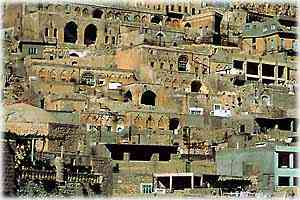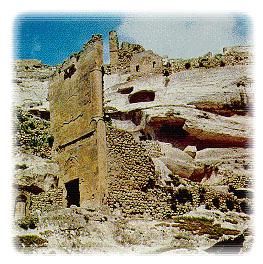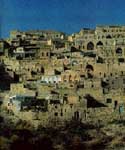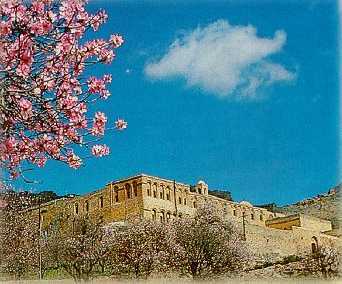

MARDiN
 The province of Mardin,
overlooking the Mesopotamian Plain, has preserved the old- style carving
in its houses. Dating from 1385, the Sultan Isa Medresse is an
interesting, beautiful Turkish monument with its magnificent carved
portal. The Kasim Pasa Medresse, is also significant for its
dome of beautiful stonework and the Ulu Mosque with
its well-decorated minaret, is
another sightseeing spot. On a hill, 7 kms east of Mardin, you will see
something you do not expect: Deynulzaferan, a Syriac- Jacobite monastery.
Several kilometres further, there is
The province of Mardin,
overlooking the Mesopotamian Plain, has preserved the old- style carving
in its houses. Dating from 1385, the Sultan Isa Medresse is an
interesting, beautiful Turkish monument with its magnificent carved
portal. The Kasim Pasa Medresse, is also significant for its
dome of beautiful stonework and the Ulu Mosque with
its well-decorated minaret, is
another sightseeing spot. On a hill, 7 kms east of Mardin, you will see
something you do not expect: Deynulzaferan, a Syriac- Jacobite monastery.
Several kilometres further, there is another Monastery, Deyrelmur dating
from the 5th- century. If you would like to see the best examples of
Artutid architecture then you have to head for
Kiziltepe, 21 kms south of Mardin, 13th- century Ulu Mosque with its fine mihrap relief and
beautifully decorated portal. At Hasankeyf which is on the borderline with
Batman province, you will see the ruins of the ancient 12th- century
capital of the Artutids. The bridge which once connected the two parts of
the city over the Tigris and the palace, are others. The 15th- century
Zeynel Bey Mausoleum nearby, is attractively decorated with blue tiles.
another Monastery, Deyrelmur dating
from the 5th- century. If you would like to see the best examples of
Artutid architecture then you have to head for
Kiziltepe, 21 kms south of Mardin, 13th- century Ulu Mosque with its fine mihrap relief and
beautifully decorated portal. At Hasankeyf which is on the borderline with
Batman province, you will see the ruins of the ancient 12th- century
capital of the Artutids. The bridge which once connected the two parts of
the city over the Tigris and the palace, are others. The 15th- century
Zeynel Bey Mausoleum nearby, is attractively decorated with blue tiles.

Mardin is an important regional trading center on the east-west trade routes of southern Anatolia. It is connected by a branch line with the Istanbul-Baghdad railway and is linked by roads with Gaziantep (west), Aleppo (in Syria), Nusaybin (southeast), and Diyarbakir (northeast).
Mardin il (4,973 sq mi [12,879 sq km]), bordered on the south by Syria, is an agricultural area chiefly producing wheat, barley, and sesame. Angora goats are raised for mohair, and there is a small cotton- and woolen-weaving industry. In addition to the Turks, the il has a large population of Arabs and Kurds. Pop. (1980) city, 39,137; (1983 est.) il, 591,200.

Monastery of Deyrulzaferan |
From a distance, the golden stone of Mardin houses blend into the rock
of the hills on which the city is built. On closer inspection, the stone carving
and decoration of the houses an public buildings reveals the city as an
architectural treasure-chest. Among the jewels are the ancient citadel and
several mosques, in particular, Ulu Mosque. The 15th century Kasim Pasa Medrese
is remarkable for its fine stonework. At the lovely Isa Bey Medrese from the
14th century, you can admire the magnificently carved portal and climb to its
roof to enjoy the fantastic view over the Mesopotamian Plain.
Only 7 kilometers east of mardin.htm is the
Syriac-Jacobite Monastery of Deyrulzaferan, which once was a thriving religious
community. Nearby at Kiziltepe, the 13th century Ulu Mosque, one of the best
examples of Artukid architecture, has superb mihrab reliefs and a beautiful
portal.
Midyat, famous for its silver objects known as 'telkari',
has many elegant, historic houses. Eighteen kilometers east of town is the
actively functioning Syriac-Jacobite monastery, Deyrelumur(San Gabriel)which
dates from the beginning of the fifth century.
![]()
Home | Ana
Sayfa | All About Turkey | Turkiye
hakkindaki Hersey | Turkish Road Map
| Historical Places in Adiyaman | Historical
Places in Turkey | Mt.Nemrut | Slide
Shows | Related Links | Guest
Book | Disclaimer | Send a Postcard | Travelers' Stories | Donate a little to help | Getting Around Istanbul | Adiyaman Forum
|
|